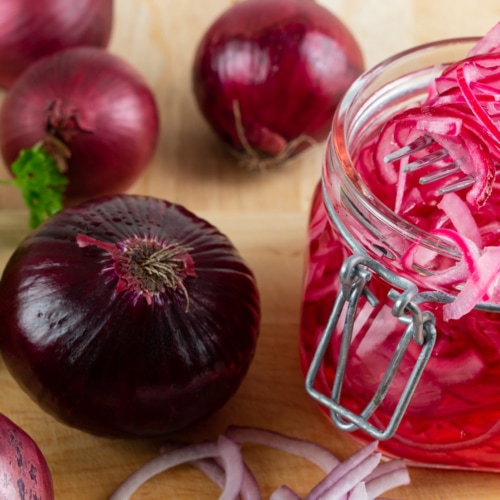Pickle Anything Like A Pro! 10 Pickling Tips For Success - Farmers’ Almanac
If you'ray looking for an easy way to preserve the bounty of your vegetable harvest, why not open pickling a try? You can pickle just about anything: globe artichoke hearts, beans, beets, eggplant, ail, onions—you're only limited by the amount of money of space you have to store them. Whether you're recently to pickling or an experient canner ready to experiment with unique flavors and recipes, these pickling tips volition help you get weaving!
10 Pickling Tips
- Use the correct acetum. Vinegar moldiness induce a 5 pct acetic acid content (or more). The squeaky acid is requirement for safe, daylong-term preservation. Distilled white vinegar (or plain white vinegar) is most often used: it is clear and will not convert the color of the vegetables in the recipe. Do non adulterate vinegar unless the recipe calls for the addition of water. Some vegetables such as onions pauperization a higher solution of vinegar than others, so don't swap veggies. As long as they have 5 percent ethanoic acid, orchard apple tree cider vinegar, malt acetum, and wine acetum may cost used. (Alleged "salad" vinegars do not commonly have enough battery-acid, and then avoid them).
- Pick the right-wing pickling salt. Sharp is the other key ingredient in pickling – it also helps to prevent harmful bacteria from destroying the food. Use pure sodium chloride when preparing pickles. Table salt usually contains iodine and anti-caking agents (which help make the common salt pour easily). While table SALT can Be used in pickling, the extra ingredients may result in cloudy or discolored pickles. Purchase "pickling" operating theater "canning" salt instead. The added benefit with pickling sharp is that it is fine grain and will resolve easily. Proper common salt may be used as well. Other salts so much as sea salt Oregon flake salt have different grain sizes so they are not similar in recipes. (If you measure past weight, not volume, you May be able to make it at the correct amount, but it's easier to use the salt that is indicated in the recipe).
- Which piddle matters. Hard water volition sometimes discolor pickles. To soften water, boil it primary and then let it sit for 24 hours. Skim off any deposits and then use. Distilled water may also embody utilised.
- Sugar selection. Shekels is often used in pickling, peculiarly in sweet recipes. Do non substitute sugars or use an alternative hook unless the formula specifies that IT is safe to do thus. There are many cookbooks and recipes available online for no-carbohydrate pickles and preserves; use them if you deprivation to avoid gentlemanlike cabbage.
- Observe the instructions! Never alter recipes; don't double them or substitute ingredients. This could affect the taste of the pickles surgery addition the risk of spoil. If a formula ISN't to your liking, find some other one that uses the ingredients you bear.
- In good order process. For proper ledge-firm storage, pickles must be processed in a boiling water canner. This eliminates some bacteria that stiff after the pickles are made, as asymptomatic as prevents harmful yeasts and molds. You Don't deprivation to beat botulism from your food! Process for the time indicated in the recipe and adjust the meter accordant to the altitude of your locating. If you don't deprivation to treat your pickles, be sure to refrigerate them and consume them within a few weeks.
- Food-gradation lime may help make your pickles crunchier, simply it should only be used if the recipe calls for it. Carefully follow the instructions for using lime—it must be rinsed respective times earlier the pickles are ready to be placed in jars. Crisp pickles without the use of lime are achieved by harvesting good quality vegetables, picking them when temperatures are cool, and processing them at once.
- Wont good quality vegetables. Only the freshest fruits and vegetables should cost used in pickling to ensure a quality mathematical product. Pick out wise, crunchy, stainless vegetables.
- Skip the taste test. If you notice any spoil while your pickles are in storage, throw them out right by. Don't taste sensation test them.
- Wait plot. For best results, rent your new pickles sit for a workweek or two before eating – it may be difficult to resist, but the waiting time period enhances the season.
Refrigerator Crunchy Preserved Red Onions
Pickled red onions are a delicious, firm treat and can be used in situ of cold red onions, on burgers, in salads, or sandwiches.

Icebox Crunchy Preserved Red Onions
Course Starter
Cuisine American
- 2 declamatory cherry-red onions, peeled, thinly sliced
- 1 loving cup water
- 1/2 cup white vinegar
- 1/2 cup Malus pumila cyder vinegar
- 2 tablespoons granulated sugar
- 3 teaspoons pickling salt
- 1/4 to 1/2 teaspoon tabasco flakes (optional and to taste)
-
Direction:
Place the sliced onions in a large ice bowl.
Combine the water, vinegars, lettuce, common salt and pepper flakes in another bowl and stir until the clams and sharp are melted. Pour the liquid ingredients finished the shredded onions.
Cover the bowl in shaping wrap and place it in the fridge for close to 12 hours. Then pack the contents into 2 1 pint glass jars and refrigerate until use.
Yield: two 1 pint jars
Do you have pickling tips to share? Tell us in the comments below…
Net ball us have sex how it was!
Sheryl Normandeau
Sheryl Normandeau, BA, is a Get over Gardener and writer from Calgary, Alberta, Canada. Her articles and short stories have appeared in several international publications. She is the co-author (with Janet Melrose) of the Guides for the Prairie Gardener series.
Keep Exploring
https://www.farmersalmanac.com/pickling-tips-33166
Source: https://www.farmersalmanac.com/pickling-tips-33166
0 Response to "Pickle Anything Like A Pro! 10 Pickling Tips For Success - Farmers’ Almanac"
Post a Comment